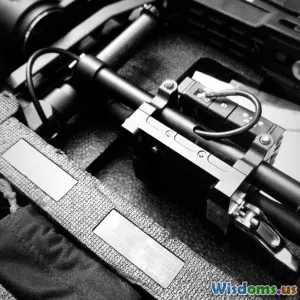
Smart Fuzes Changing the Battlefield for Precision Bombs
10 min read Explore how smart fuzes are revolutionizing precision bombs through innovative technology enhancing battlefield accuracy and reducing collateral damage. (0 Reviews)
Smart Fuzes Changing the Battlefield for Precision Bombs
Introduction
The dawn of precision-guided munitions marked a seismic shift in modern warfare, allowing forces to neutralize targets with unprecedented accuracy. Yet, even the most sophisticated precision bombs still faced a critical component that largely dictated the effectiveness of their detonation: the fuze. Traditional fuzes, often mechanical or basic proximity sensors, have long limited the adaptability and overall efficiency of bombs once deployed.
Enter smart fuzes—a technological innovation that is fundamentally changing how precision bombs operate on the battlefield. These advanced fuzes can sense, process, and decide optimal detonation moments with remarkable intelligence, thus enhancing the tactical capabilities of aerial ordnance.
This article explores how smart fuzes are revolutionizing precision bombs, the technology behind them, their tactical advantages, and their transformative impact on modern combat scenarios.
What Are Smart Fuzes?
Smart fuzes are an advanced generation of bomb fuzing technology that incorporate a variety of sensors, processors, and algorithms enabling real-time decision-making about when and how to detonate a warhead. Unlike traditional contact or timer fuzes, smart fuzes leverage microelectromechanical systems (MEMS), radar, laser sensors, and sometimes even artificial intelligence (AI) to assess the environment and target geometry.
Historical Evolution
Initially, bomb fuzes were simplistic: timed to explode after a certain duration or triggered upon impact. This rigidity meant that a bomb might detonate prematurely or too late, reducing lethality or increasing risk to unwanted areas. Gradually, proximity and altimeter fuzes improved effectiveness by detonating near targets rather than on impact, but they offered limited adaptiveness.
The rapid advancements in sensor miniaturization, computational power, and communications technologies during the late 20th and early 21st centuries catalyzed the development of smart fuzes. According to the U.S. Department of Defense, smart fuzes could adjust detonation parameters dynamically based on changing conditions, offering superior precision and operational flexibility.
How Smart Fuzes Work
Sensor Integration
Smart fuzes integrate multiple sensor types:
- Radar Sensors: Measure the distance from the target to facilitate airburst detonations.
- Laser Rangefinders: Offer precise distance measurements for timing detonations.
- Inertial Measurement Units (IMU): Monitor bomb trajectory and velocity.
- Optical Sensors and Cameras: Aid in target recognition and adaptive decisions.
These sensors collaborate to provide a comprehensive picture of the bomb’s position and environmental parameters in real-time.
Real-Time Processing and Decision-Making
The heart of the smart fuze is an embedded processor running sophisticated algorithms to decide:
- Optimal detonation altitude for maximum effect.
- Whether to airburst above, contact the target, or delay until penetration is sufficient.
- Adaptations if the bomb deviates from its intended course or if the target moves.
For instance, some smart fuzes use AI models trained on battlefield data to recognize when detonation would cause maximum damage to a target while minimizing collateral impact on civilian structures.
Communication with Delivery Platforms
Certain smart fuzes can receive information or update settings mid-flight via encrypted datalinks. This dynamic interaction allows commanders to alter detonation parameters even after the bomb has been released, offering unprecedented battlefield control.
Battlefield Advantages of Smart Fuzes
Improved Targeting Precision
Smart fuzes enhance bomb effectiveness by ensuring detonation at the exact moment for maximal impact on the target. For example, airburst explosions can disperse shrapnel over a wider radius against troops in cover or lightly armored vehicles, whereas delayed penetration detonation can neutralize bunkers or hardened underground facilities.
A 2019 study by the RAND Corporation indicated that smart fuzes, when combined with precision-guided munitions, increased target kill probability by up to 40% compared to conventional fuzes.
Reduced Collateral Damage
With sensitive environmental awareness and intelligent decision-making, smart fuzes help prevent unnecessary destruction. They can discriminate between primary targets and non-combatants or adjust fuzing if civilians or sensitive infrastructure are detected nearby.
This capability is crucial in modern asymmetrical warfare environments—urban warfare zones like Mosul or Raqqa highlight the challenges of minimizing civilian casualties while neutralizing enemy combatants.
Operational Flexibility and Cost Efficiency
Smart fuzes reduce the need for multiple munition types tailored to specific missions. For instance, a single smart fuze-equipped precision bomb can substitute multiple traditional bomb variants by adapting its detonation style mid-mission.
Moreover, by increasing first-strike lethality, they reduce the number of bombs needed to neutralize a target, which results in cost savings and reduced logistical burdens.
Real-World Applications and Examples
U.S. Military Use: Laser Guided Bombs (LGB) and Joint Direct Attack Munition (JDAM)
Smart fuzes complement weapon systems like the GBU-54 Laser JDAM, combining laser guidance and GPS to strike with meter-level accuracy. For example, the Ruggedized Fuze for GBU-53/B Small Diameter Bomb integrates multiple sensors to adapt detonation dynamically.
The U.S. Air Force’s employment of smart fuze-equipped bombs in conflicts such as Operation Inherent Resolve against ISIS demonstrates improved effectiveness in urban environments.
Russian Innovations: UPAB-1500B Precision Bomb
Russia has developed smart fuzes incorporated into their UPAB-1500B series that can be programmed to execute airburst or delayed-time detonations, giving them flexibility against fortified or dispersed targets.
Technological Trailblazers: Beyond Bombs
Smart fuze technology is also influencing other weapon systems like artillery shells and mortar rounds. The XM1156 Precision Guidance Kit by the U.S. Army uses similar adaptive fuzing and guidance to convert standard artillery into precision rounds.
Challenges and Considerations
Technological Complexity and Cost
Developing smart fuzes involves high R&D investment, intricate engineering, and costly manufacturing processes. Ensuring robustness in harsh combat environments while maintaining affordability remains challenging.
Electronic Countermeasures (ECM) Vulnerability
Smart fuzes' reliance on sensors and communication raises concerns over susceptibility to jamming, spoofing, or hacking. Continuous efforts in cybersecurity and signal hardening are pivotal.
Ethical and Legal Implications
While minimizing collateral damage, reliance on autonomous or semi-autonomous decision-making prompts debates about accountability and ethics in lethal use of force.
The Future of Smart Fuzes and Precision Bombing
Looking ahead, smart fuzes are poised to become increasingly integral to precision munitions. Advances in AI, sensor fusion, and miniaturization will enable:
- Full autonomy in target selection and detonation decisions.
- Networked ordnance capable of coordinating multiple simultaneous strikes.
- Enhanced battlefield awareness integrating data from UAVs, satellites, and ground troops.
Countries investing heavily in these technologies will likely gain a strategic advantage in future conflicts, underlining the critical role of smart fuzes in modernizations of military arsenals.
Conclusion
Smart fuzes represent a groundbreaking leap in munitions technology, pushing the boundaries of what precision bombs can achieve. By fusing sensor technology, data processing, and adaptability, they allow for precision not only in delivery but also in the exact moment and method of detonation.
This accurate and flexible approach reduces collateral damage, optimizes operational outcomes, and transforms the tempo of modern warfare. As combat environments grow increasingly complex, smart fuzes will remain a key enabler for militaries seeking to balance lethality with restraint.
Embracing the potential of smart fuzes is not just about technological superiority; it is about evolving strategies to create safer, more effective outcomes on today's and tomorrow's battlefields.
Author: AI Defense Analyst
Rate the Post
User Reviews
Other posts in Explosives and Ordnance
Popular Posts
















